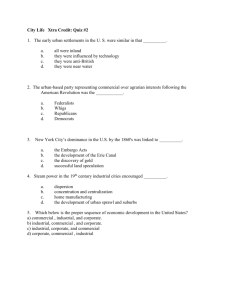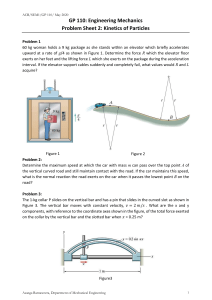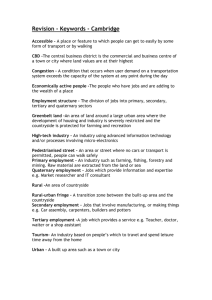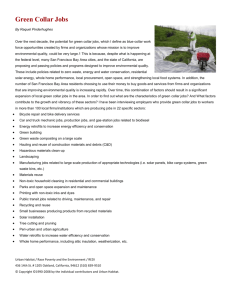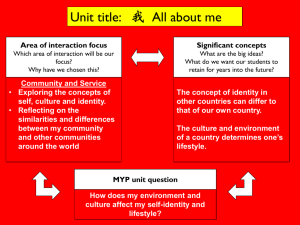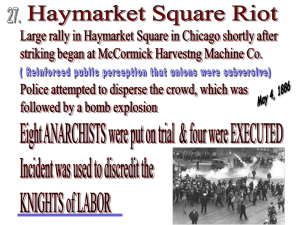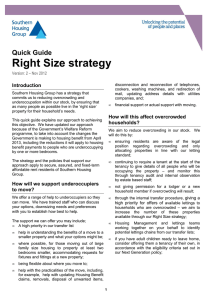APUSH – Road to Revolution
advertisement
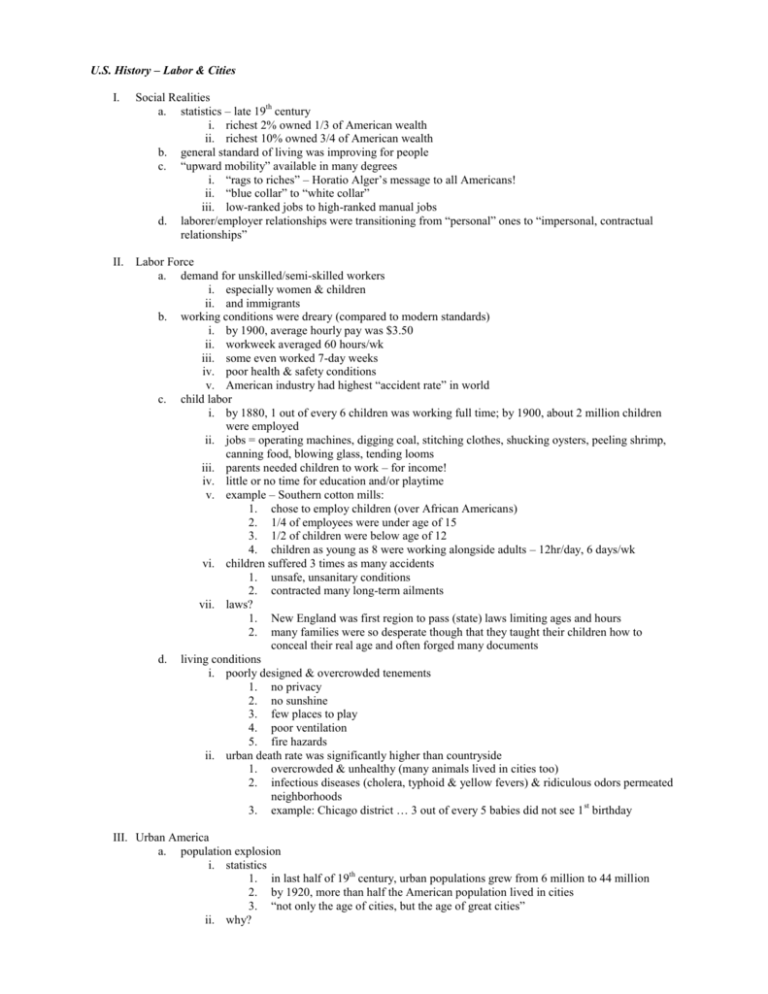
U.S. History – Labor & Cities I. Social Realities a. statistics – late 19th century i. richest 2% owned 1/3 of American wealth ii. richest 10% owned 3/4 of American wealth b. general standard of living was improving for people c. “upward mobility” available in many degrees i. “rags to riches” – Horatio Alger’s message to all Americans! ii. “blue collar” to “white collar” iii. low-ranked jobs to high-ranked manual jobs d. laborer/employer relationships were transitioning from “personal” ones to “impersonal, contractual relationships” II. Labor Force a. demand for unskilled/semi-skilled workers i. especially women & children ii. and immigrants b. working conditions were dreary (compared to modern standards) i. by 1900, average hourly pay was $3.50 ii. workweek averaged 60 hours/wk iii. some even worked 7-day weeks iv. poor health & safety conditions v. American industry had highest “accident rate” in world c. child labor i. by 1880, 1 out of every 6 children was working full time; by 1900, about 2 million children were employed ii. jobs = operating machines, digging coal, stitching clothes, shucking oysters, peeling shrimp, canning food, blowing glass, tending looms iii. parents needed children to work – for income! iv. little or no time for education and/or playtime v. example – Southern cotton mills: 1. chose to employ children (over African Americans) 2. 1/4 of employees were under age of 15 3. 1/2 of children were below age of 12 4. children as young as 8 were working alongside adults – 12hr/day, 6 days/wk vi. children suffered 3 times as many accidents 1. unsafe, unsanitary conditions 2. contracted many long-term ailments vii. laws? 1. New England was first region to pass (state) laws limiting ages and hours 2. many families were so desperate though that they taught their children how to conceal their real age and often forged many documents d. living conditions i. poorly designed & overcrowded tenements 1. no privacy 2. no sunshine 3. few places to play 4. poor ventilation 5. fire hazards ii. urban death rate was significantly higher than countryside 1. overcrowded & unhealthy (many animals lived in cities too) 2. infectious diseases (cholera, typhoid & yellow fevers) & ridiculous odors permeated neighborhoods 3. example: Chicago district … 3 out of every 5 babies did not see 1 st birthday III. Urban America a. population explosion i. statistics 1. in last half of 19th century, urban populations grew from 6 million to 44 million 2. by 1920, more than half the American population lived in cities 3. “not only the age of cities, but the age of great cities” ii. why? in search of jobs, wealth, & excitement (came from countryside & overseas) could consider the Western migration an urban movement of its own (thanks to railroads) 3. in times of rural depression, cities lured people in 4. technological innovation allowed for expansion vertically a. the buildings themselves (cast-iron & steel-framed) b. better heating (radiators vs. fire places) c. Otis Elevator Co.’s first electric elevator (1889) 5. expansion also occurred horizontally due to technology a. cable cars (that clamped onto an underground cable) b. steam-powered trains c. electric trolleys (1890s) d. eventually subways iii. began to “sprawl” into suburbs 1. expanded further (horizontally) 2. began segregating people based on economic status 3. cities became primarily populated by working class (poorer districts became more congested and criminally inclined) the urban “environment” i. push for reform 1. make cosmetic adjustments 2. remove causes of ever-present diseases ii. action 1. banished hogs & cattle from cities 2. pushed for clean-up campaigns 3. improved water/sewage systems 4. trash collection 5. electric streetcars to replace horses iii. domino effect 1. manure shortage for farmers on outskirts – even “night soil” from outhouses was used in agriculture 2. waste pushed off on land was now being put in waterways politics i. development of urban political machines 1. local committeemen 2. district captains 3. political boss ii. corruption 1. bosses often granted patronage favors 2. buying & selling of votes 3. kickbacks & payoffs iii. bosses also provided needed services: 1. distribution of coal 2. distribution of food 3. money given to the poor 4. helped to find work for those out of a job 5. sponsored language classes for immigrants 6. organized entertainment (sports teams, social clubs, neighborhood gatherings) iv. “There’s got to be in every ward somebody that any bloke can come to – no matter what he’s done – and get help. Help, you understand, none of your law and justice, but help.” – one ward boss from Boston, MA 1. 2. b. c.

